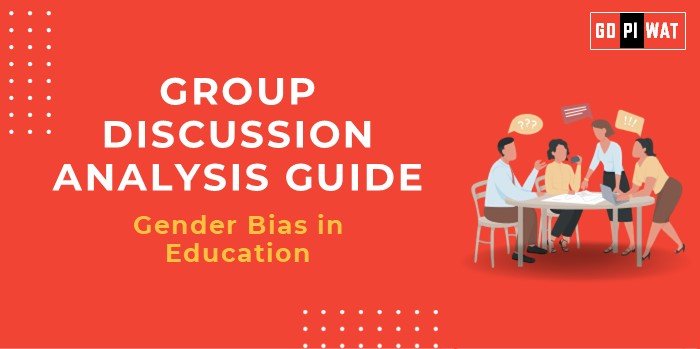📋 GD Analysis: Gender Bias in Education
🌐 Introduction to Gender Bias in Education
📖 Gender bias in education remains a significant issue in India, affecting access and the quality of learning experiences for students. Despite progress in enrollment rates, disparities persist, particularly in rural areas and marginalized communities. Addressing gender bias is critical, as education equity can unlock substantial economic, social, and developmental benefits.
📊 Current State of Gender Bias in Indian Education
- 📉 Enrollment and Literacy Rates: Female literacy in 2018 was 65.7%, compared to 82.3% for males. Dropout rates for girls remain high at the secondary level.
- 🌍 Regional Disparities: Gender gaps are more pronounced in rural northern states compared to urban areas in eastern India.
- 📚 Subject Segregation: Fewer girls opt for science and commerce at the higher secondary level, leading to underrepresentation in high-paying fields.
📊 Quick Facts and Key Statistics
- 🌍 Global Literacy Gender Gap: 94% of the global literacy gap has closed, but regions like Sub-Saharan Africa lag with gender parity scores below 55%.
- 🎓 STEM Workforce Representation: Women occupy only 28% of STEM roles globally, reflecting persistent bias.
- 📈 Primary Education Parity: 65 countries have achieved full parity in primary enrollment, but disparities persist in nations like Mali and Chad.
🤝 Stakeholders and Their Roles
- 🏛️ Government and Policymakers: Develop policies to bridge gender gaps, including incentives and legal protections.
- 🏫 Educational Institutions: Implement gender-sensitive policies and improve infrastructure to create inclusive learning environments.
- 🤝 Nonprofits and Advocacy Groups: Raise awareness and provide resources for equal educational access.
- 👨👩👧👦 Parents and Communities: Shape gender perceptions and support girls’ education through community-led initiatives.
🎯 Achievements and Challenges
🌟 Achievements:
- 📈 Increased Enrollment: Programs like Beti Bachao, Beti Padhao have significantly improved girls’ primary enrollment rates.
- 💰 Scholarships and Financial Aid: Conditional cash transfers incentivize families to educate girls.
- 🚻 Infrastructural Improvements: Separate sanitation facilities for girls in schools have boosted attendance rates.
⚠️ Challenges:
- 🧠 Socio-Cultural Norms: Beliefs prioritizing boys’ education persist, especially in rural areas.
- 📉 Economic Constraints: In low-income families, resources are often allocated to boys’ education, while girls handle household chores.
🌍 Global Comparisons
- 🇫🇮 Finland: A leader in gender-equitable education, offering insights on curriculum design and stereotype reduction.
- 🇵🇰 Pakistan: Faces challenges with gender parity due to economic and social constraints, particularly in rural areas.
📖 Case Study:
Kenya has successfully implemented free primary education, support for female teachers, and gender-sensitive policies, showcasing a path toward equity.
📄 Structured Arguments for Discussion
🔹 Supporting Stance: “Equal access to education for girls leads to improved economic and social outcomes, empowering entire communities.”
🔹 Opposing Stance: “Addressing gender bias in education requires overcoming deeply ingrained social norms, which cannot be resolved solely through policy changes.”
🔹 Balanced Perspective: “While programs and policies have narrowed gender gaps in education, persistent cultural and economic barriers continue to hinder full gender parity.”
📊 Effective Discussion Approaches
- 📈 Statistics-Driven Start: Share impactful data, such as high dropout rates among girls at the secondary level.
- 📖 Case Study Introduction: Refer to successful examples like Finland’s gender-neutral education approach.
- ⚖️ Counter-Argument Handling: Emphasize the economic benefits of educating girls as a rebuttal to cultural constraints.
💡 Strategic Analysis
Strengths:
- 📢 Increased global advocacy for gender equity in education.
- 📜 Government-led initiatives such as Beti Bachao, Beti Padhao.
Weaknesses:
- 🧠 Persistent cultural biases in rural communities.
- 📉 Economic disparities limiting girls’ access to education.
Opportunities:
- 🌐 Use of technology to deliver remote learning and digital literacy programs.
- 🧪 Expansion of STEM programs tailored to encourage female participation.
Threats:
- 📉 Community resistance in conservative areas.
- 💰 Economic downturns reducing funding for gender-equity programs.
📚 Connecting with B-School Applications
- 💼 Real-World Applications: Use insights on gender bias in projects on CSR, diversity and inclusion, and economic development.
- 🎓 Sample Interview Questions:
- “How can B-schools contribute to reducing gender bias in education?”
- “What are the economic implications of closing the gender gap in education?”
- 💡 Insights: Highlights the role of education in fostering diversity, equity, and inclusion, essential for global leadership and innovation.


